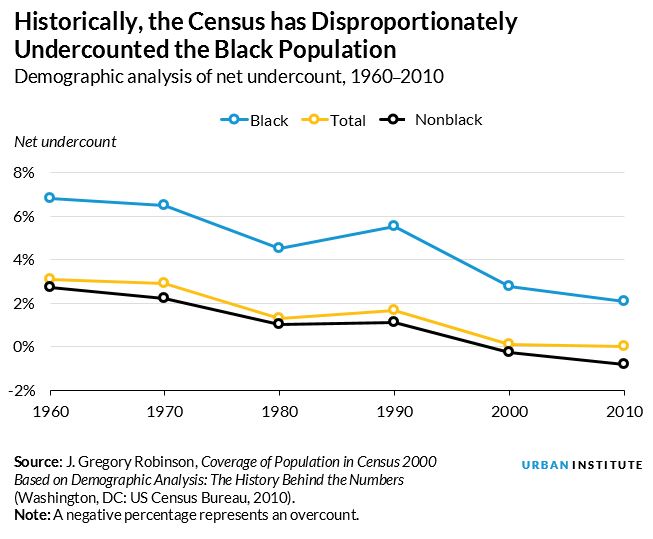
Photo by Ceres Van Hal / EyeEm via GettyImages.
The 2020 Census is a little more than a year away, and its approach is generating interest about demographic changes in the United States, as well as uncertainties about how well we will be able to see those changes. The possibility of the Census including a citizenship question, for instance, has placed the complex decennial survey under public scrutiny and will be taken up by the Supreme Court.
But other concerns about Census funding and how people might respond when they receive their census instructions in the mail have particular importance for the quality of the count for populations at risk of underrepresentation.
Black communities across the United States have been undercounted for decades in decennial censuses. An undercount represents the difference between an estimate from a post-enumeration survey or a demographic analysis and the official Census counts. There are many reasons why this undercount exists, including people having multiple addresses or different family structures.
In the 1990 Census, staff at the Decennial Statistical Studies Division of the Department of Commerce estimated a net undercount of about 4 percent for African Americans. It improved to 2 percent—or about 800,000 people—in the 2000 Census (PDF), but the most recent Census in 2010 showed no significant change to the black undercount, despite the net undercount being the lowest it had been in history.

The undercount is an acute problem for black men. In 2015, the New York Times ran an interactive feature called “1.5 Million Missing Black Men,” raising alarm, and for good reason. Although other researchers at the Urban Institute have detailed their critiques of the Times’ methodology, the fact remains that black men (PDF) experience higher rates of incarceration and premature mortality rates, causing many of them to be “missing” in their communities. But it is more difficult to engage these problems at the local level when the basic census data are distorted by undercounts.
Children younger than 5 are also systematically undercounted in decennial censuses, especially black children. Researchers estimated that in 1990, the net undercount for black children hovered around 8 percent, while that of the nonblack population was closer to 3 percent.
In other words, young black children were underrepresented at twice the rate of their nonblack peers in the 1990 Census. In 2010, young black children were still undercounted at twice the rate as young nonblack children—affecting federal funding allocations to programs that are supposed to serve them (PDF), like the Supplemental Nutrition Assistance Program, the Temporary Assistance for Needy Families program, and the National School Lunch Program.

Staff at the Census Bureau, local partners, and advocates work hard to reduce these counting disparities. But the problem has unfortunate parallels to the very first census, where the black undercount was deliberate and constitutionally designed. When the Constitution was being drafted in 1787, legislators argued about who was eligible to be counted in the population and how that decision would affect the apportionment of seats in the House of Representatives.
The Three-Fifths Compromise dictated that each enslaved African American was counted as three-fifths of a person. States and localities with large enslaved communities benefited from the count in terms of federal funding and political power and, simultaneously, made it clear who did and did not “count” as a whole person.
Today, black communities aren’t the only ones undercounted; non-Hispanic white communities are more likely to be overcounted. This differential counting in our census means that wealthier, white communities receive “more than their fair share” of resources and representation.
The census is a constitutionally mandated enumeration of the US population. Its counts facilitate the apportionment of seats in the US House of Representatives, shape decisions around the allocation of federal financial assistance, and are the basis for redrawing legislative boundaries. In other words, census data tell a social, economic, and demographic story, and policymakers at every level of government rely on these data to make decisions that reflect the country’s democratic aspirations.
Black communities deserve to be accurately represented in the census. Despite the census being chronically underfunded over the past decade, state-driven local outreach—as well as mobilization efforts like the Black Census Project and Data for Black Lives—can help move the country toward that goal. The Black Census Project, for example, was born out of a desire to tell a more nuanced story of black life in the United States and “inform, influence, and impact” institutions with far-reaching decisionmaking power.
Lawmakers and businesses cannot make responsible decisions without an accurate census. And communities cannot hold them accountable without it.
Let’s build a future where everyone, everywhere has the opportunity and power to thrive
Urban is more determined than ever to partner with changemakers to unlock opportunities that give people across the country a fair shot at reaching their fullest potential. Invest in Urban to power this type of work.